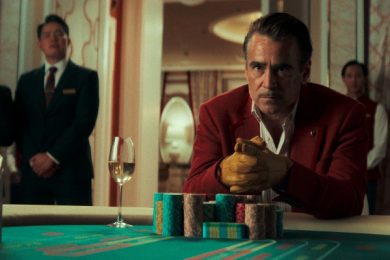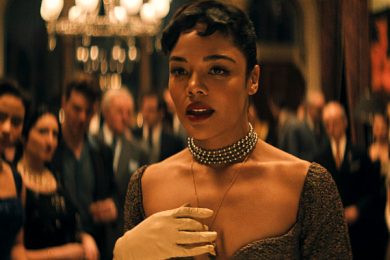David Ayer makes Man Movies with a capital M. His films are a bit more cerebral than, say, the Expendables franchise, but in the end both selection of films are reaching toward the same core audience and have the same spiritual conscience. He wrote the screenplay for the first Fast and the Furious movie and Training Day, so we should know what we’re getting into with all his films at this point. His best film, End of Watch, was a brilliant, cinema-verite style document of brotherhood between two LAPD officers (played wonderfully by Jake Gyllenhaal and Michael Peña) facing great danger together in South Central. That film managed to find sympathy for police officers in a social climate that makes that incredibly difficult. Ayer taps into bromance in the most masculine way possible. It’s homoeroticism for the homophobes, finding an almost philosophical wonder within male companionship. In Fury, Ayer takes these male relationships and places them into World War II, focussing on a tank crew that rides through Germany in the waning months of the war. The tank is striking, even amongst all the rest of them, with a cannon that sticks out like a giant erection and the word “FURY” written in white paint on the side of it. It is the home of the men that Ayer introduces to us here.
The head of the tank crew is Wardaddy (Brad Pitt), an ice cold Army Sergeant completely hardened by the horrors of the war. In his crew, he has Bible (Shia LeBeouf), the pious, mustachioed gunner of the tank; the loader is Coon-Ass (Jon Bernthal), a crude, yellow-teethed Southern boy; and the driver is Gordo (Michael Peña), a Mexican observer, the most reactive of the whole crew. The movie begins not long after the death of the their assistant driver, and when they arrive at their base, they’re introduced to the replacement: a baby-faced teenager named Norman (Logan Lerman) who’d originally enlisted as a typist clerk. Unimpressed by their fresh new crew member, the crew asks Norman to clean pieces of a soldier’s face out of the inside of their tank as an inauguration. Norman is nervous, unprepared and has zero combat experience. Placed in the tank, and given a gun to fire, Norman is at best a nuisance and at worst a danger to rest of the crew with his incompetence. This is not an unusual trope: a virginal newcomer baptized by fire by the violence of war. When Wardaddy physically forces Norman to shoot a German prisoner, the newcomer’s innocence is lost. Norman is so overcome by the action, that Wardaddy takes him aside and explains “Ideals are peaceful. History is violent.”
And this is the film’s central conflict. Turning Norman into a killing machine is necessary for his new position, but Fury sometimes gets caught between its “War is Hell” ideology and the “War Makes Men” mythology. The truth is probably somewhere in between those two poles of logic, but Ayer sometimes doesn’t really understand the subtlety of the discussion. He hits both beats so hard that its sometimes confusing to figure out what Fury is trying to say. And perhaps digging for meaning is missing the point, and Fury is no more popcorn entertainment than his Fast and the Furious movie. But this film seemed to aspire to be more. Last week, I saw Whiplash which did a phenomenal in dealing with the complexities between the abuser and the abused, and showcasing our new world thinking versus the old school belief that tough love makes greatness. Fury doesn’t have that complexity, and from scene to scene it seems to want different things. It’s easy to look at Ayer’s other films – including the Arnold Schwarzenegger vehicle Sabotage, which came out earlier this year – and assume that Ayer is all for the masculinity of killing. Ayer’s better films seem to suggest more thoughtfulness. His filmmaking acumen is on point, and there are tank battle sequences in Fury that are rippled with suspense, despite the lumbering nature of tank movement. It’s the storytelling ability that needs to catch up.
The film has a sequence in its middle, when the tanks encounter a small German town where they get the German soldiers to surrender. Wardaddy notices a German woman hiding in her apartment and brings Norman with him to scope it out. The woman (Anamaria Marinca) says she’s alone in the apartment, but it doesn’t take long for Wardaddy to find Emma (Alicia von Rittberg), her teenaged cousin, hiding under the bed. The two women are frightened by the two men, whose faces are blackened by gun smoke, but Wardaddy quickly defuses the situation, gives the woman eggs to cook and for all of them to eat and even encourages Norman when its obvious that Emma wants to be intimate with him. They both flee to the bedroom and Wardaddy explains to the woman, “They’re young. And they’re alive”. The scene turns when Bible, Coon-Ass and Gordo find the situation, and turn the quaint meal into a crude display, hurt by Wardaddy’s choice to bring Norman to the apartment instead of any of them. The scene is a welcome interlude to the movie’s brutality, but still shows an obvious harshness to these soldiers. It’s not unlike the French rubber plantation sequence of Apocalypse Now Redux (which was left entirely out of the theatrical version), in its relaxed yet sobering view of the war coming face to face with the common people.
It’s the film’s most interesting half hour and the one that most clearly illustrates what it wants to say. You can tell that the actors appreciated having a scene not inside the cramped space of a tank, and it’s the only chance the film gives Brad Pitt to prove why he’s in the movie to begin with. Pitt played a WWII leader of men in Tarantino’s Inglourious Basterds, but that performance was complete satire. In Fury, Pitt is playing sincerity and as is common with the actor’s more middling performances, the focus of the character seems to vary from scene to scene. But it does not during that sequence in the German woman’s apartment, which would act wonderfully as its own short film, a meeting of minds on a battlefield much different than the ones that these soldiers are used to. Some of Fury‘s scenes can be seen from a mile away. For all its striving for honest portrayal, it still more or less proceeds the way every other hackneyed WWII film did before it. Format isn’t Ayer’s strong suit, and he usually just takes the most common route to tell a story and hopes that the uniqueness of the characters is what separates his films. It worked in End of Watch and his script for Training Day, but there are too many WWII films made to expect to stick out in this way.
The movie’s performances are solid, and even though I am a self-proclaimed Shia LeBeouf hater, I must praise his work here as striking and leveled. His version of the Army soldier felt the most lived-in and melancholy of them all; his closeness to God a flimsy shield against the horrors of his actions. Bernthal and Pena give their characters their due, but there’s not a whole lot there for the actors to work with. It’s laughably convenient that Fury’s crew covers all the demographical bases, a one-tank example of the melting pot of America. It’s a bit of an obvious touch. Fury does have several mesmerizing battle scenes, equipped with Game of Thrones-level violence that is extreme, for sure, but never seems gratuitous. Whether the film is meant to be gore-fest entertainment, or a harrowing anti-war screed is, I guess, left up to the viewer. Some have already blamed Fury for glamorizing violence and adding to war-hungry, gun-toting American culture that doesn’t exactly need the encouragement. But it’s hard to come up with any strong conclusions about this movie from a single viewing. The film’s ideals may be peaceful, but the film itself sure is violent.
Written and Directed by David Ayer









